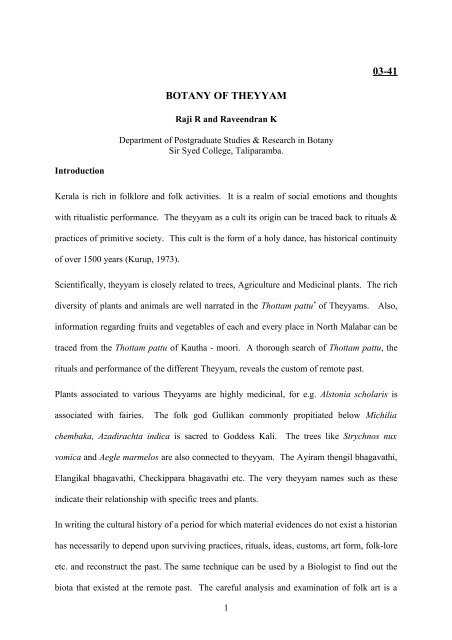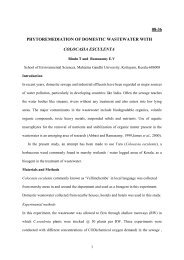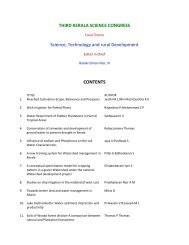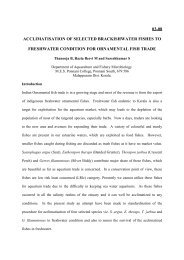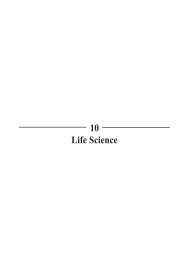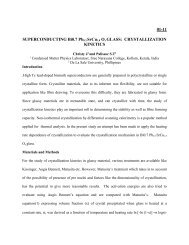BOTANY OF THEYYAM
BOTANY OF THEYYAM
BOTANY OF THEYYAM
- TAGS
- botany
- theyyam
- 210.212.24.72
Create successful ePaper yourself
Turn your PDF publications into a flip-book with our unique Google optimized e-Paper software.
Introduction<br />
<strong>BOTANY</strong> <strong>OF</strong> <strong>THEYYAM</strong><br />
Raji R and Raveendran K<br />
Department of Postgraduate Studies & Research in Botany<br />
Sir Syed College, Taliparamba.<br />
03-41<br />
Kerala is rich in folklore and folk activities. It is a realm of social emotions and thoughts<br />
with ritualistic performance. The theyyam as a cult its origin can be traced back to rituals &<br />
practices of primitive society. This cult is the form of a holy dance, has historical continuity<br />
of over 1500 years (Kurup, 1973).<br />
Scientifically, theyyam is closely related to trees, Agriculture and Medicinal plants. The rich<br />
diversity of plants and animals are well narrated in the Thottam pattu * of Theyyams. Also,<br />
information regarding fruits and vegetables of each and every place in North Malabar can be<br />
traced from the Thottam pattu of Kautha - moori. A thorough search of Thottam pattu, the<br />
rituals and performance of the different Theyyam, reveals the custom of remote past.<br />
Plants associated to various Theyyams are highly medicinal, for e.g. Alstonia scholaris is<br />
associated with fairies. The folk god Gullikan commonly propitiated below Michilia<br />
chembaka, Azadirachta indica is sacred to Goddess Kali. The trees like Strychnos nux<br />
vomica and Aegle marmelos are also connected to theyyam. The Ayiram thengil bhagavathi,<br />
Elangikal bhagavathi, Checkippara bhagavathi etc. The very theyyam names such as these<br />
indicate their relationship with specific trees and plants.<br />
In writing the cultural history of a period for which material evidences do not exist a historian<br />
has necessarily to depend upon surviving practices, rituals, ideas, customs, art form, folk-lore<br />
etc. and reconstruct the past. The same technique can be used by a Biologist to find out the<br />
biota that existed at the remote past. The careful analysis and examination of folk art is a<br />
1
good source for him to trace the folk medicine. Method of treatment of various diseases, the<br />
way of dressing, preparation of natural colours and way of paintings, manufacturing<br />
technique of cloths, bangles, ear rings, crowns and other makeup materials using different<br />
wood and plant materials. It also indicates various types of firewoods used for different<br />
aspects of performance. The medicinal food and vegetable crops planted during those days<br />
find scientific evidence in Korathi thottam. The method of food preparation under highly<br />
hygienic condition has clear representation in the Muthappan oottuvellattam performance.<br />
*Devotional songs accompanying Theyyam.<br />
Materials and Methods<br />
The information and details were collected from various places in Kannur, Wayanadu and<br />
Kasargode. The present study includes collection of information from theyyam performers<br />
and experts with an analysis of this data. They describe theyyams of Pottan, Mari,<br />
Wayanattukulavan and Muchilottu bhagavathi.<br />
Makeup and costumes<br />
Every theyyam varies from other, in few or many aspects in their costumes and makeup’s.<br />
The face of theyyam is painted with natural colours. Colours prepared from Curcuma<br />
domestica, Oryza sativa- (white), (green) from Albizia lebbeck, Abrus precatorius, Ricinus<br />
communis. Artocarpus hetrophilla a gammy exudates is used as the gum. The necklace and<br />
bangles are made up of Enythrena indica.<br />
The dressings of the Pottan theyyam include crown, oliyuduppu, Aravalayan, thalapali,<br />
Poykkathu, poymukham, Kazhuthilkettu, Kazhuthilpoo, Nakham etc. The crown, oliyuduppu,<br />
Poykkathu,makham etc. are made by using tender coconut leaves (Cocos nucifera). The belt<br />
fastening the waist, called Aravalayan is made up of Erythrena indica, flowers - Ixora<br />
coccnea are arranged above this. A special item called ‘ Viruth’ is seen above the bangles<br />
2
and is made up of Caryota urens. The theyyam wear a mask of Areca catechu. The body of<br />
the Kolam is coloured with Oryza Sativa.<br />
Wayanattu kulavan<br />
The crown is circular. It is made by using the stem of Mussaenda frondosa, Areca catechu,<br />
Ochlanda rheed, Bambusa arundinaceae Calycopteris floribunda. The waist dress is in red<br />
and white cloth. The body is painted with colours.<br />
Muchilottubhagavthi<br />
Mudi is circular and made up of Bambusa arundinaceae and Caryota urens and are covered<br />
with colour cloths and flowers. The face of the player is painted with colours. The ear rings,<br />
breast plate, necklace are made up of Erythrena indica.<br />
Mari theyyam<br />
The dressing of the theyyam includes only the tender coconut leaves (Cocos nucifera). The<br />
performance of this theyyam begins with handling of Piper betle and Areca catechu. During<br />
the performance this theyyam visits houses. A specially prepared solution called Gurusy<br />
(Curcuma domestica+Calcium Carbonate) is taken by the kolam and sprayed around the<br />
houses. The members of the houses donate Oryza sativa, Capsicum annum, Vitex negundo,<br />
Curcuma domestica, Cocos nucifera, avil, malar, (Oryza sativa) Pepper, beetle, Areca<br />
catechu, Brassica juncea, sodium chloride and Carbon to the kolam.<br />
During the performance of Pottan theyyam and Muchilottu Bhagavathi, an interesting aspect<br />
is that the performer leaps into a heap of burning wood called “Meleri”, this meleri is<br />
specially arranged for this purpose. The meleri is erected by burning the wood of plants like<br />
Artocarpus heterophyllus, Mangifera indica, Alstonia scholaris and Michelia champaka.<br />
Prasadam<br />
Pottan Cocos nucifera, avil, malar (Oryza sativa)<br />
Wayanattu kulavan – coconut, toddy (Cocos nucifera) avil, nerippada, (Oryza sativa)<br />
3
Muchilottu Bhagavathi – Turmeric powder (Curcuma domestica)<br />
Results and Discussion<br />
The analysis of the above data shows that 36 plants are closely associated with the four<br />
theyyams encountered in the project. (Table No. 1) Though all the 36 plants are medicinal,<br />
most important are listed below – Albizia Lebbeck Benth, Alstomia scholaris L.R.Br,<br />
Bambusa arundinacea (Retz.) Willd, Calycopteris floribunda Lam., Colocasia esculentra<br />
(Linn) schott, Cocor uncefra L., Curcuma domestica valet, Erythrena indica, Ficus<br />
bengalensis L., Ixora coccinea Linn, Magnifera indica L., Michelia champaka L.,<br />
Mussaenda frondosa L., Ocimum sanctum L., Piper betle L., Piper nigrum L., Plumeria<br />
rubra Linn, Pterocurpus santalinus, Ricinus communis L., Sandalum album, Tamarindus<br />
indica, Terminalia bellerica (Gaertn) Roxb, Vitex nugundo Linn.<br />
The very title of this discourse “Botany of Theyyam” is of a mixed response. It is a<br />
harmonious mix of science and sociology. The amazement to the common man comes<br />
naturally when a concept like theyyam is juxtaposed with a term ‘Botany’. The reason for<br />
such a juxtaposition is part of the unveiling of this subject.<br />
Informers: -<br />
1. V.V. Ramaperuvannan, Kuppam. P.O., Taliparamba<br />
2. Ratheesh P.K.Chanapuzha, Karimbam, Taliparamba<br />
3. K.M. Mani, Porur, P.O. Wayanad<br />
4. Gopalan, Chudala<br />
Acknowledgments<br />
The authors are obliged to Principal and Management of Sir Syed College, Taliparamba for<br />
their timely help.<br />
Reference<br />
Chandera C.M.S. Theyyathinte Aadi Roopam,, D C Books<br />
4
Kurup K K N , (1973), The Cult of Theyyam and Hero Worship in Kerala, Centre for<br />
Folklore studies, University of Calicut, Theyyam, Dr. M V Vishnu Namboothiri<br />
Purohit, S S, Arun K Sharma, Tarun Kumar, (2003), A handbook of medicinal plants-A<br />
complete source Book. Agro bios India Narayan Das Prajapati<br />
Vishnu Namboothiri M.V , Kali Sankalpam Kerala Parisarathil.<br />
Vishnu Namboothiri M.V, Pottan Theyyam<br />
Vishnu Namboothiri M.V, Thottam Pattukal Oru Padanam<br />
5


